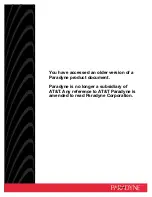
Accubar SDI-12 Barometric Pressure Sensor Operations & Maintenance Manual Rev-B 30 Nov 2017
pg. 10
atttn
and
a
where a is the address, ttt is the amount of time, in
seconds, the ACCUBAR
®
needs to make the
measurement or process the command and n is the
number of values that can be collected. In this form the
sensor will also respond with its address when the data
is ready to collect. This response is called a service
request.
If you issued the
change address
command or the
identify
command described in the previous sections,
you already have some experience with using ACCUBAR
®
commands. There are other commands
available to make measurements, set the type of output units for the measurements, perform special
scaling of the measurements, etc. The following sections describe the commands by function.
Making a Measurement
There are four classes of measurement commands which will be referred to as M commands
(Measurement Commands), C commands (Concurrent Measurement Commands), MC commands
(Measurement commands with CRC-16), and CC commands (Concurrent Measurement Commands with
CRC-16). Concurrent measurement commands are new to version 1.2 of the SDI-12 specification. The
commands with CRC-16 are new to version 1.3 of the SDI-
12 specification. In the original class of “M”
measurement commands, the data recorder issued the measurement command and then waited for the
sensor to complete the measurement before continuing the data collection cycle. Only one sensor
could be accessed at a time and a maximum of nine parameters could be returned. With version 1.2 of
the specification, concurrent measurements were defined. With a concurrent measurement, the data
recorder can request the sensor to take a measurement, determine how long it will be until the sensor
has a reading, and then continue on making requests to other sensors on the SDI-12 bus. This way
multiple sensors are taking measurements concurrent with each other. Once the measurement time for
a sensor has expired the data recorder polls the sensor for the data. The CRC-16 commands that were
added in version 1.3 of the specification add a 16 bit cyclic redundancy check (CRC-16) to the returned
data values. This provides an additional means for the data recorder to ensure that the collected data
has not been corrupted.
Selecting a Measurement Command Class
Always supported
The first requirement is that the data recorder support the command. All SDI-12 data recorders
support the non-concurrent measurement M command. With the M command the data
recorder collects data from the sensors one at a time.
Multiple long measurement time sensors
When collecting data from several SDI-12 sensors that have long measurement times, the
complete data collection cycle can be shortened by utilizing concurrent commands. The data
The data recorder can initiate the measurement on all the sensors and when each finishes, then
collect the data from all of them. Since the measurement times overlap, the complete data
collection cycle is shorter. There is no advantage to the concurrent measurement C command
when there is only one sensor.











































